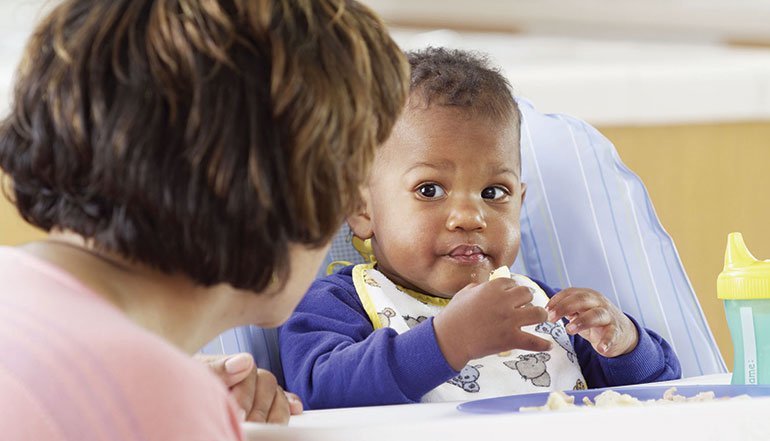If you adopt a newborn or baby, you’ll be overseeing his transition from an entirely liquid diet of formula to meals that resemble yours, in miniature form. But when is baby ready for that first bite? And what should be on the menu? What if you adopt a toddler who didn’t receive adequate nutrition during her first years of life? Keep in mind that every child develops differently and you may need to feed your child according to his nutritional needs, not, necessarily, his age.
Don’t Ban the Bottle Yet
When an infant is consuming only formula, he should be fed six to 10 times a day. As your baby starts eating solid foods, he will drink less. As you slowly increase the amount of solid food you offer, you should decrease the amount of formula. As a general rule, if your baby is drinking more than 32 ounces in 24 hours, it is time to offer more solid food. There is no rush to wean your baby from the bottle, however. Bottle-feeding is a wonderful way to promote attachment, and I encourage any parents adopting a child under age one to do it. Even if your newly adopted toddler has been off a bottle for several months, he will probably return to it easily when he realizes that it is such a pleasurable, comforting experience. Never let your child doze off during a bottle feeding, however. Milk will collect in her mouth, and may cause choking, ear infections, and tooth decay. Once those first little teeth appear, you should get into the habit of brushing them twice daily, once in the morning and once after the final bottle-feeding at night. Talk to your pediatrician about what to put in the bottles. Infants need formula until their first birthday. Many adopted toddlers could benefit nutritionally from continuing on formula beyond one year, before switching to whole milk. One liquid that should never go into your child’s bottle is juice. If your child is a good eater, and/or is taking a multivitamin, juice is merely “empty calories.” I generally recommend that newly adopted children stay away from water, as well. While drinking water is great for kids, your child may need to maximize calorie intake.
First Bites
Generally, children should start eating an iron-fortified, single-grain baby cereal shortly after they turn four months old. Follow these guidelines to ensure a smooth switch.
- Use a spoon. Never give your baby solid foods, such as thinned-out rice cereal, in a bottle. This may cause choking or lead to overeating, and it can slow development of your baby’s feeding skills.
- Sit up. Always feed your baby in an upright position. You may need to support your infant’s head and neck during meals, if his motor control is delayed.
- Watch closely. Newly adopted infants may not know when they are hungry or full. Some hungry babies fuss or cry, or watch you very carefully as you eat. Once they start eating, some may have trouble stopping. You can help manage this by offering only one or two choices at a time, and work on slow, relaxing mealtimes.
- Hold the salt. When you move on to fruits and vegetables, serve them simply cooked and puréed, with no added salt or sugar.
- Go slowly. Some kids arrive with medical records suggesting that they have food allergies, though these are not that common. Stay away from spicy foods, introduce new tastes one at a time, and watch for reactions.
Take your time in introducing foods, even if you have an eager, interested feeder on your hands, and you long to fill his belly! Soon enough, he’ll be sitting down to eat with the rest of the family.



